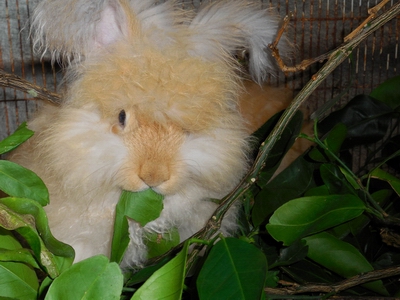
Wet grumpy bunnies! There's been rain for what seems like weeks, sometimes sideways rain. The bunnies aren't really thrilled with this new level of dampness. They're getting to the point of downright grumpiness. And as everyone knows, a grumpy bunny is not a happy bunny. Hopefully we will get some sunshine and some fresh happy dandelions soon.
So far the worst part has been when the rain blew into Tootsie's nest. She's in the new nest area which didn't quite get officially finished because of the constant rain. There's supposed to be more roof on it, it's got what I thought was enough, but not with this amount and this direction of rain. The new baby bunnies got soaked through and all the bunny fluff that Tootsie had so carefully pulled off and used for her nest was all soaked, flattened and nothing other than a soggy mess. The poor baby bunnies were soaked, soggy and damp. They were not happy at all although I think they're too young yet to have figured out how to be grumpy. They were merely very unhappy. Fortunately, Tootsie had been hiding in the nest box from the rain so the babies were snuggled up with her and survived. They were warm - plus they had mum nearby for snacks so they were just very soggy. They now have some dry nesting material and new dry bunny fluff, and some feed bags wired up to sides of the new nesting area to keep the sideways rain out. Hopefully, anyway.
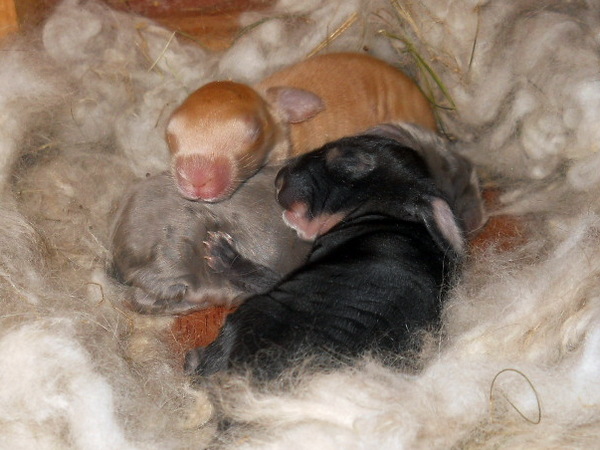
These are Tootsie and Sydney's new babies. There's three of them, so the litter is much smaller than her last one which had seven in it. But, hey! Three is better than none! I'm about ready to call the penicillin treatment a 100% success.
The penicillin treatments were started on February 21st and the whole bunny herd here at Hillside Farm Hawaii plus a visiting bunny were given weekly shots. Several of our best bunny wranglers came over to help since every bunny was getting a shot every Wednesday for five weeks. One bottle of Durapen penicillin lasted for the entire treatment session and it's surprisingly inexpensive. It's supposed to be used for cattle so one cow sized bottle will treat a LOT of bunnies.
We did use quite a few needles since we got the really small bunny sized ones. They'd bend if the needle tip landed on an area with wool on it. It's pretty hard to find bare skin on these bunnies! It took longer to find a bare spot than to actually give them the shot. But, needles that small are surprisingly inexpensive. So the whole treatment system of penicillin shots for twenty one bunnies for five weeks which required a bottle of penicillin and about eight needles and syringes had a cost of less than twenty dollars. It would have been a lot more expensive if they'd been cattle or horses or something much bigger. It's nice to have 'micro' livestock! (Ooops! Don't tell the bunnies they're livestock. So far they are certain that they are cuddly pets instead of official livestock.)
Since the whole penicillin treatment was to treat 'Vent Disease' which is basically rabbit syphilis (which fortunately doesn't cross species lines) the smaller litter sizes could be from internal damage done by the disease. It's also still pretty early in the investigative stages of how effective the treatment was as well. So far, we've gone from no baby bunnies, done a five week penicillin treatment and are now seeing baby bunnies again. However, one of the things syphilis does is damage reproductive systems. So, bunnies who used to have large litters, may not have as many babies now. Which could be damage from syphilis and not from the penicillin treatment not being 100% effective. Once these new babies are old enough to have litters of their own, we will be able to see if they will have larger litters.
Now that we're beginning to get baby bunnies again, it's kinda interesting to see the range of color possible within one 'color' of bunny. I'm thinking two of the new baby bunnies are both tortoiseshells, but one is a whole lot darker than the other.
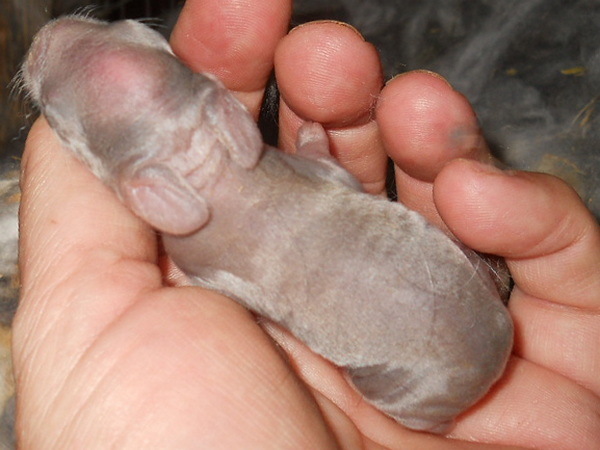
This is the first tortoiseshell baby bunny. Ziggy and Sydney had two babies, one is a black with a Vienna mark and the other is this tortoiseshell. This first picture was from when it was just several days old. It almost looks like a chocolate, although the color darkens up a bit over the feet and head so it's a tort instead of a chocolate or lilac.
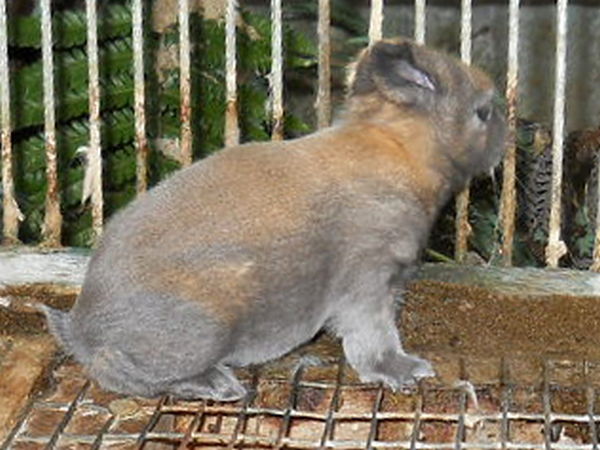
A week later and we can see the tortoiseshell pattern showing up. Tortoiseshell is where the black color in each hair shaft doesn't extend to the end of the hairshaft over the the body of the bunny. The extremities such as the head and feet still have the original color since the color extends to the ends of those hairs. When charting bunny colors on a gene chart, this would be under the 'E' gene. The dominant 'E' has the color extending to the end of the hair shaft on all hair shafts. When there's two recessives at the 'E' location in the genes (i.e. 'ee'), then that's when this tortoiseshell color pattern shows up.
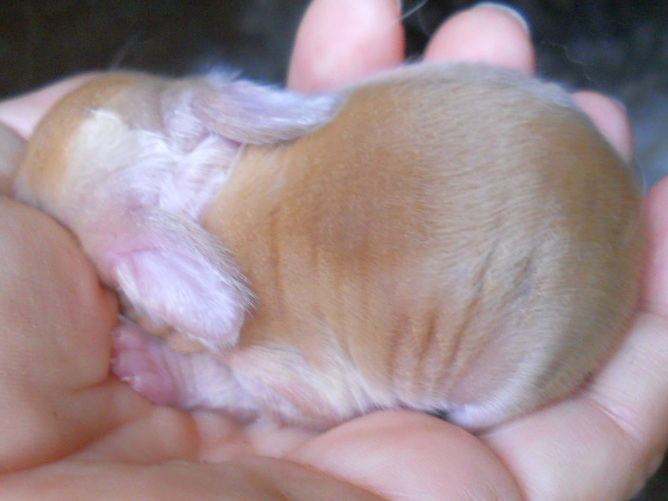
I'm pretty sure this is another tortoiseshell bunny, but it's awfully light colored. If those ears have a white lining (that I can't quite see yet?) then it will be a fawn bunny instead of a tortoiseshell. The fawn is another version of 'the-color-doesn't-get-to-the-end' type of color. If it's a fawn, then it's actually got two color patterns going on. The first color pattern would be the agouti color pattern that has the inside of the ears, around the eyes, under the tail and the whole undercarriage of the bunny in white. Added to that is the tortoiseshell pattern of the black (or chocolate) color not extending the full length of the hairs on the body of the bunny. Those two patterns together create a 'fawn' instead of a 'tortiseshell'.
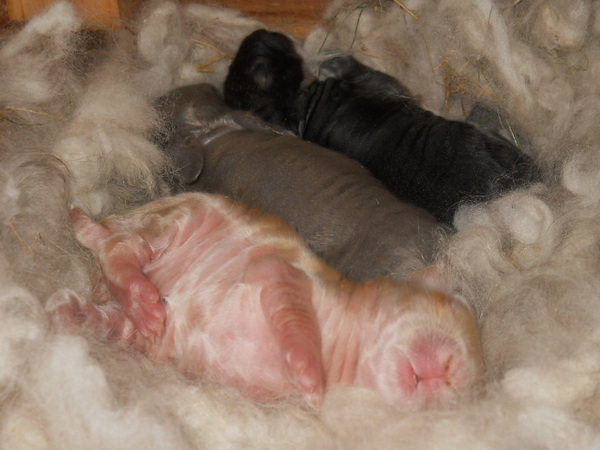
This picture has the bottom of the tortoiseshell bunny showing. Kinda looks like a white belly? But not as white as I'd expect? It's pretty hard to tell the exact colors of really baby bunnies, in a couple of days hopefully there will be some more clues.
For a regular agouti colored bunny, not only do they have the white around their eyes, in their ears, under their tail and the white undercarriage, but each hair shaft is banded in colors. If you blow into the wool, it will show up like rings as the color bands blow over. Kinda amazing, when you think about it. As a baby bunny, they will be all black with pink/white in their ears and really pink bellies.

It is the same picture from the top of the page, but it does show the agouti markings on the baby black bunny pretty well. The black baby bunny in the litter will be 'agouti' as an adult. That's the most dominant color of bunnies, the genetic code is A_ B_ C_ D_ E_. Agouti has at least one dominant on each spot in the color gene chart and can hide all sorts of recessives behind the dominant color that is visible. For color genes, it only takes one dominant to make that color show up. All three of these in the first slot on the genetic color code will show the same agouti color pattern: 'AA' or 'Aa' or 'A_' (the blank line means we don't know what's there). Since the agouti color pattern is all dominant genes, that's also why wild bunnies are almost always agouti colored.
In the litter above, the black one is agouti colored, the yellow one is either fawn or tortoiseshell, and the gray one is either blue or lilac. Fawn and tortoiseshell are similar colors except the fawn has white in certain areas. The blue is a diluted black and the lilac is a diluted chocolate color so 'blue' is sort of a cold color of gray while the 'lilac' is a warmer shade of gray.
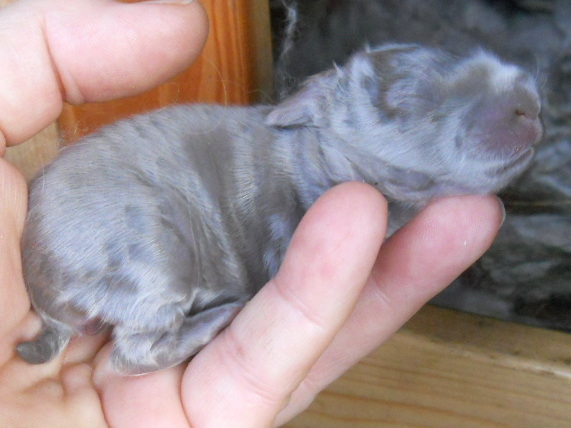
I'm pretty sure this little one will be a 'blue' baby and not a 'lilac' baby. The color seems more on the silvery side, lilac is a different shade of gray.
Oh, and just to keep the confusion going, there's several different types of tortoiseshell, too. Depending on the color of the nose, feet and ears, it can be a 'black tortoiseshell', a 'chocolate tortoiseshell' or a 'lilac tortoiseshell'. A lilac tort is almost all color recessives - it takes two 'a' recessives to get a solid colored bunny (i.e. not an agouti). It takes two recessive 'b's to get chocolate instead of black. A lilac tortoiseshell must have at least one dominant 'C' gene or it will be an albino and not show any color at all. There can still be a recessive 'c' hiding behind the one dominant C that makes the color show up, though. To get the diluted chocolate color which is lilac requires two recessive 'd's. And to get the tortoiseshell color pattern where the black/chocolate color doesn't extend to the end of the hair shaft over the body parts of the bunny, that needs a pair of recessive 'e's. So, genetically speaking, the color code for a lilac tortoiseshell is aa bb C_ dd ee.
I'm guessing the little light colored one is going to be fawn instead of tort, though. In a couple more days it will be more apparent.

We could continue with genetic color code discussions and discuss the Vienna gene which is responsible for this white mark on the baby bunny's head. However, no need to try for a mental meltdown, we'll just post the cute baby bunny picture of 'Dot'. At least the white mark seems smaller now that the bunny has grown a bit bigger. It's still a disqualification on the show table though, so no bunny shows in the future for this one. They have started opening their eyes, though. And running around out of the nest more often as well. Pretty soon Ziggy will be hanging out on top of the nest box to stay away from the annoying offspring but at least there's only two of them. Sometimes with really big litters the doe gets really tired of baby bunnies pretty quickly.